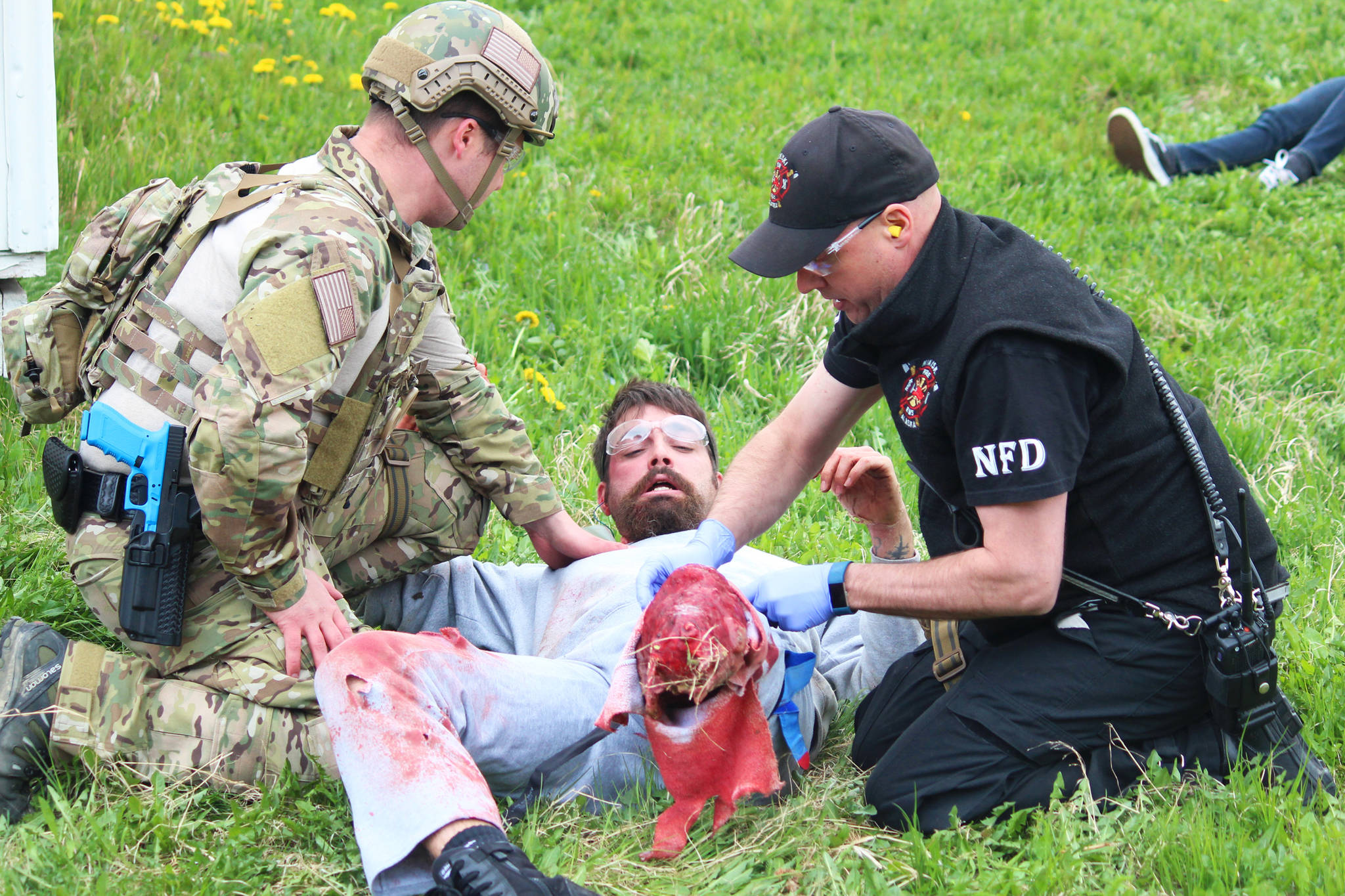“Julie, I brought my extra blood and Visqueen… if you want a puddle,” said Alaska Department of Health and Social Services employee Todd Lecours as he and about 30 other people scurried about the North Peninsula Recreation Center on Saturday.
What might seem like an odd thing to have on hand was essential to put the finishing touches on several emergency simulations that a class of law enforcement officers and emergency medical responders were about to go through. Members representing several Kenai Peninsula agencies spent the day completing four drills, all designed to test how they work together on calls that turn dangerous or violent. The simulations included a meth lab explosion with a shooter, two active shooter situations in different parts of a school and a situation involving a sniper.
The drills and the multi-day course leading up to them were led by JTM Training Group, a Las Vegas-based company that provides training around the world, teaching everyone from civilian groups to SEAL Team Six, said Julie Rabeau, trauma program manager for DHSS. The group has come to Alaska for the last six years to provide the course through a federal preparedness grant, she said.
“When I moved here nine years ago I was seeing people needlessly dying and knowing that … through evidence-based medicine and how things are done differently now, that we could bring this training to Alaska to help with our law enforcement and our pre-hospital and hospital emergency department people to save more lives,” Rabeau said.
The course, called Tactical Emergency Casualty Care, is based off military models where the response is integrated with medics working more closely with law enforcement to get patients out and into treatment more quickly.
“It’s to decrease morbidity and mortality,” Rabeau said. “And the second thing is the way the world is now, we have to respond different than how we did years ago, where law enforcement would go in, and then pre-hospital would stage somewhere … a mile away waiting for the scene to be clear. Then they would go in. Well we know after some of these incidents that we’ve seen … that incidents are over quickly, that … we can bring EMS in sooner.”
Agencies came from all over the peninsula to be involved in the training, including the Alaska State Troopers, Homer Police Department, Central Emergency Services, the Nikiski, Girdwood and Kenai fire departments, Kachemak Emergency Services and employees from Spring Creek Correctional Center. JTM will be hosting another course later this week in Kenai for members of peninsula agencies that weren’t able to participate in the first one.
During the drills, the course classmates had to approach the situations as if they were real, coordinate their responses and communicate well with each other throughout. They were given instructions by William “Billy” Butler, operations supervisor for JTM, to stop their response and tend to any gunshot wounds they received from the role players, who fire cotton balls or paintballs, before carrying on.
Butler did not reveal what kind of scenarios awaited the trainees, but reminded them to work together.
“It’s everyday calls that you guys might go on that could turn violent,” he told them.
Rabeau said that, generally, law enforcement and first responder agencies work together but don’t often train together, so the drills can be a challenge.
“Bringing two different entities like that, there’s usually problems associated with that,” she said. “From training, it teaches them … better communication, better understanding of how to collaboratively bring these patients in from there and understanding each other’s roles,” she said.
The scenarios were brought to life with the help of about 17 young volunteers, some from Nikiski Middle-High School and some recent graduates from the community. Adorned with fake burns, wounds and concussions and coated in “blood” dispensed from a spray bottle, they played shooters and victims that had to be tended to while a threat was being removed.
The roleplayers eagerly got into their respective characters.
“My stomach hurts,” said 16-year-old Cheyanne Wall as she waited in the recreation center with her peers for the drills to start.
“I know how you feel,” countered 15-year-old Joseph McLeod, lifting up his crew neck to reveal a painted-on stomach wound.
Five groups of trainees went through each of the four drills on Saturday, rotating through them until they had experienced each simulation. Following each drill, they were asked to debrief and discuss how they fared and how they could improve.
Rabeau said the skills and lessons learned in the training course are hopefully taken back to each individual agency to manifest in into some kind of rescue task force or a generally more integrated response to emergencies in the future.
Reach Megan Pacer at megan.pacer@peninsulaclarion.com.

